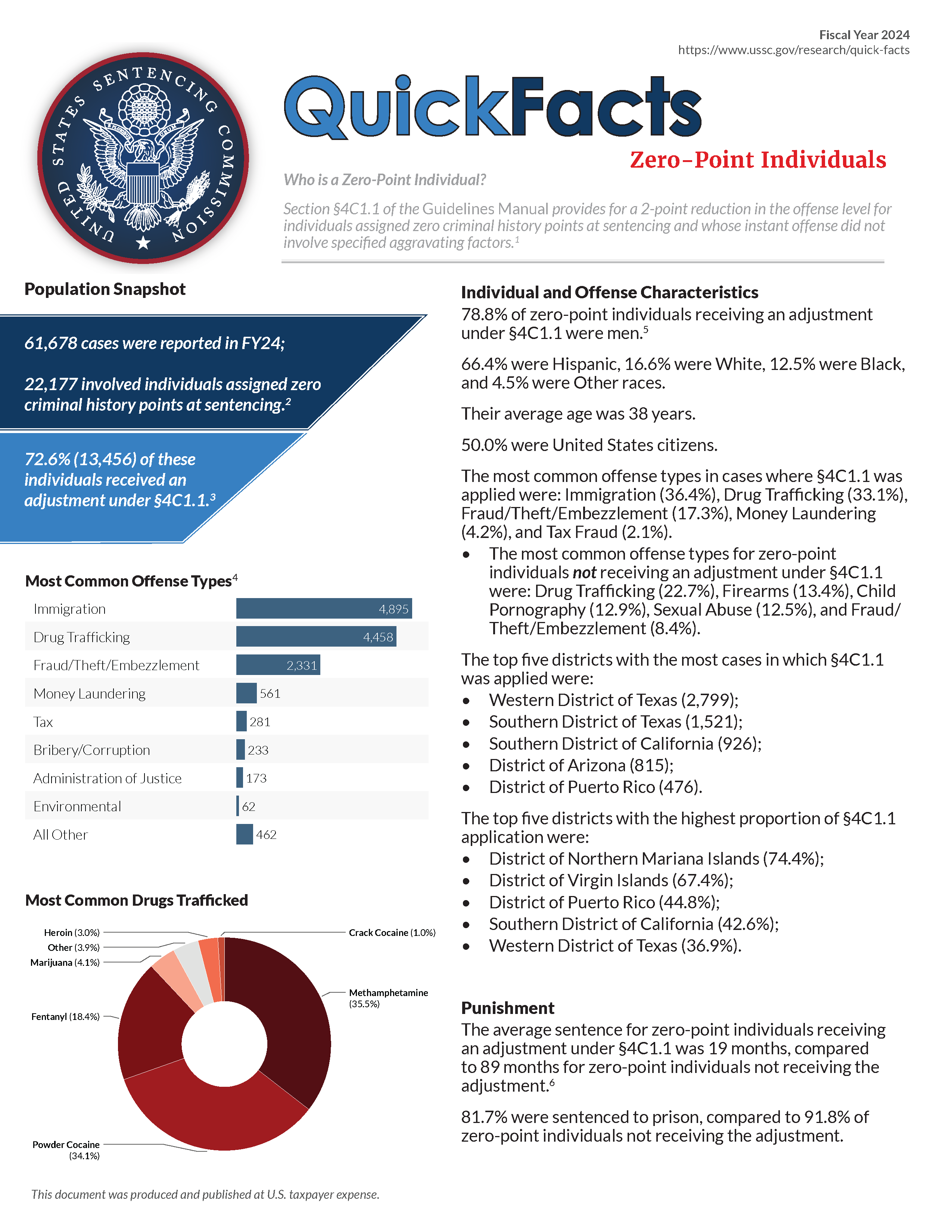Who is a Zero-Point Individual?
Section §4C1.1 of the Guidelines Manual provides for a 2-point reduction in the offense level for individuals assigned zero criminal history points at sentencing and whose instant offense did not involve specified aggravating factors.1
Of the 61,678 cases reported to the Commission in fiscal year 2024, 22,177 involved individuals assigned zero criminal history points at sentencing.2 Of these individuals, 72.6% (13,456) received an adjustment under §4C1.1.3
Click the cover for the PDF handout or learn more below.
Individual and Offense Characteristics
- 78.8% of zero-point individuals receiving an adjustment under §4C1.1 were men.5
- 66.4% were Hispanic, 16.6% were White, 12.5% were Black, and 4.5% were Other races.
- Their average age was 38 years.
- 50.0% were United States citizens.
- The most common offense types in cases where §4C1.1 was applied were: Immigration (36.4%), Drug Trafficking (33.1%), Fraud/Theft/Embezzlement (17.3%), Money Laundering (4.2%), and Tax Fraud (2.1%).
- The most common offense types for zero-point individuals not receiving an adjustment under §4C1.1 were: Drug Trafficking (22.7%), Firearms (13.4%), Child Pornography (12.9%), Sexual Abuse (12.5%), and Fraud/ Theft/Embezzlement (8.4%).
- The top five districts with the most cases in which §4C1.1 was applied were:
- Western District of Texas (2,799);
- Southern District of Texas (1,521);
- Southern District of California (926);
- District of Arizona (815);
- District of Puerto Rico (476).
- The top five districts with the highest proportion of §4C1.1 application were:
- District of Northern Mariana Islands (74.4%);
- District of Virgin Islands (67.4%);
- District of Puerto Rico (44.8%);
- Southern District of California (42.6%);
- Western District of Texas (36.9%).
Punishment
- The average sentence for zero-point individuals receiving an adjustment under §4C1.1 was 19 months, compared to 89 months for zero-point individuals not receiving the adjustment.6
- 81.7% were sentenced to prison, compared to 91.8% of zero-point individuals not receiving the adjustment.
- 18.0% were convicted of an offense carrying a mandatory minimum penalty, compared to 38.4% of zero-point individuals not receiving the adjustment.
- 84.2% of those individuals convicted of an offense carrying a mandatory minimum penalty were relieved of that penalty, compared to 15.6% of zero-point individuals not receiving the adjustment.
Sentences Relative to the Guideline Range
- 72.0% of sentences in cases with an adjustment under §4C1.1 were under the Guidelines Manual.
- 51.2% were within the guideline range.
- 10.5% were substantial assistance departures.
- The average sentence reduction was 65.5%.
- 7.4% were Early Disposition Program (EDP) departures.7
- The average sentence reduction was 61.1%.
- 2.7% were some other downward departure.
- The average sentence reduction was 59.0%.
- 51.2% were within the guideline range.
- 28.0% of sentences in cases with an adjustment under §4C1.1 were variances.
- 25.5% were downward variances.
- Their average sentence reduction was 53.0%.
- 2.5% were upward variances.
- Their average sentence increase was 76.1%.
- 25.5% were downward variances.
1 Effective November 1, 2023, sentenced individuals are eligible for an adjustment under §4C1.1 if they meet the criteria specified under §4C1.1(a)(1) – (a)(11). Individuals sentenced prior to November 1, 2023 are eligible to seek a reduction in their sentence through the retroactive application of this provision under §1B1.10 but are not included in this analysis.
2 Cases with incomplete sentencing information were excluded from the analysis.
3 In fiscal year 2024, 3,665 individuals were assigned zero criminal history points but sentenced prior to the November 1, 2023 effective date of §4C1.1 and are not included in this analysis.
4 Individuals sentenced for drug trafficking were sentenced under §§2D1.1 (Drug Trafficking), 2D1.2 (Protected Locations), 2D1.5 (Continuing Criminal Enterprise), 2D1.6 (Use of a Communication Facility), 2D1.8 (Rent/Manage Drug Establishment), 2D1.10 (Endangering Human Life), or 2D1.14 (Narco-Terrorism).
5 Among zero-point individuals who did not receive an adjustment under §4C1.1, 86.8% were men, 35.8% were Hispanic, 81.2% were United States Citizens, and their average age was 38 years.
6 The average guideline minimum for zero-point individuals receiving an adjustment under §4C1.1 was 28 months, compared to 115 months for zero-point individuals not receiving the adjustment.
7 "Early Disposition Program” (or EDP) departures are departures where the government sought a sentence below the guideline range because the defendant participated in the government’s Early Disposition Program, through which cases are resolved in an expedited manner. See USSG §5K3.1.
SOURCE: United States Sentencing Commission, FY 2020 through FY 2024 Datafiles, USSCFY20-USSCFY24.

